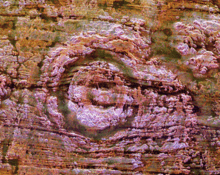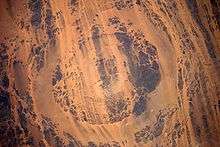Aorounga crater

Aorounga is an eroded meteorite impact crater in Chad, Africa. The exposed remnant of the crater is 12.6 km in diameter and its age is estimated to be less than 345 million years (Carboniferous or younger).[1] [2]
The crater is accompanied by two nearby circular features revealed by Space Shuttle SIR-C radar. These may be related impact craters, and if correct, Aorounga may be part of a crater chain. On the assumption that this hypothesis is correct, the exposed Aorounga crater is sometimes referred to as Aorounga South. The central highland, or peak, of the crater is surrounded by a small sand-filled trough; this in turn is surrounded by a larger circular trough. Linear rock ridges alternating with light orange sand deposits cross the image from upper left to lower right; these are called Yardangs by geomorphologists. Yardangs form by wind erosion of exposed rock layers in a unidirectional wind field. The wind blows from the north-east at Aorounga, and sand dunes formed between the yardangs are actively migrating to the south-west.
References

- ↑ "Aorounga". Earth Impact Database. University of New Brunswick. Retrieved 2009-08-12.
- ↑ VINCENT P.M., BEAUVILAIN A., 1996. Découverte d'un nouveau cratère d'impact météoritique en Afrique : l'astroblème de Gweni-Fada (Ennedi, Sahara du Tchad). C.R. Acad. Sci. Paris, t. 323, série II a, pp. 987-997.*
Coordinates: 19°6′N 19°15′E / 19.100°N 19.250°E

